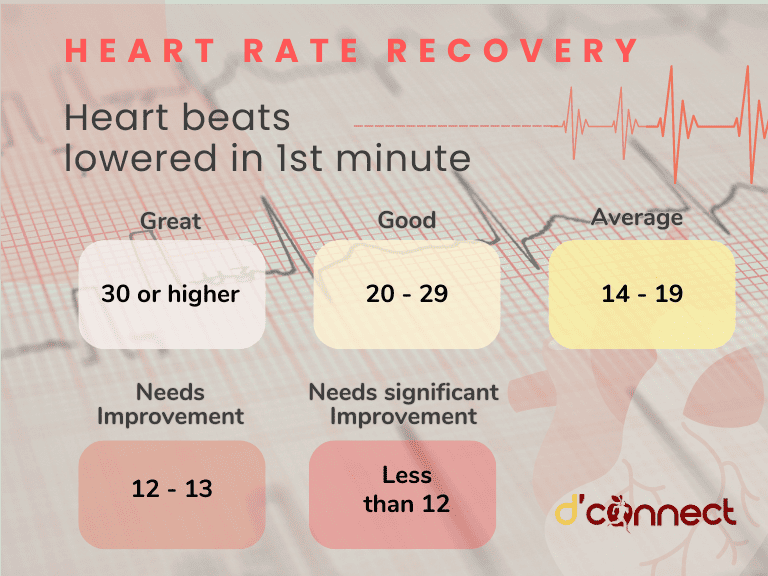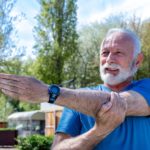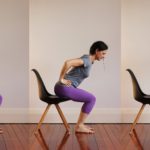
Kim Hoffmann
NASM CES (Corrective Exercise Specialist) and Certified Personal Trainer
Since many reading this article will be just starting out with zone training, we’ve decided to share some of the most important “technical expressions” to be mindful of.
Today we will be talking about
- Resting heart rate
- Maximum heart rate
- Rate of perceived exertion
- Heart rate recovery
Also, we will look into differences between aerobic and anaerobic training.
Resting Heart Rate (RHR)
Resting heart rate indicates the number of heart beats at rest, when we are doing no activity. It might vary from 60 beats per minute (bpm) to up to 100 bpm.
Women have a higher heart rate than men with an average of 78-82 bpm, while men are generally around 70-72 bpm.
There are other factors that can negatively impact our heart rate, such as
- coffee
- cigarettes
- medicines
- emotions
An anxious person will have a higher heart rate
Our age and general health can also affect our heart rate. The older we get, the more our heart rate slows down. Also, the fitter we are, the slower our heart beats.
Slower heart rate generally means that the heart is functioning efficiently and that we are physically fit.
Resting Heart Rate Chart | ||||||
Age | 18 – 25 | 26 – 35 | 36 – 45 | 46 – 55 | 56 – 65 | 65+ |
Athlete | 49 – 55 | 49 – 54 | 50 – 56 | 50 – 57 | 51 – 56 | 50 – 55 |
Excellent | 56 – 61 | 55 – 61 | 57 – 62 | 58 – 63 | 57 – 61 | 56 – 61 |
Great | 62 – 65 | 62 – 65 | 63 – 66 | 64 – 67 | 62 – 67 | 62 – 65 |
Good | 66 – 69 | 66 – 70 | 67 – 70 | 68 – 71 | 68 – 71 | 66 – 69 |
Average | 70 – 73 | 71 – 74 | 71 – 75 | 72 – 76 | 72 – 75 | 70 – 73 |
Below Average | 74 – 81 | 75 – 81 | 76 – 82 | 77 – 83 | 76 – 81 | 74 – 79 |
Poor | 82+ | 82+ | 83+ | 84+ | 82+ | 80+ |
Women (beats per minute) | ||||||
Age | 18 – 25 | 26 – 35 | 36 – 45 | 46 – 55 | 56 – 65 | 65+ |
Athlete | 54 – 60 | 54 – 59 | 54 – 59 | 54 – 60 | 54 – 59 | 54 – 59 |
Excellent | 61- 65 | 60 – 64 | 60 – 64 | 61 – 65 | 60 – 64 | 60 – 64 |
Great | 66 – 69 | 65 – 68 | 65 – 69 | 66 – 69 | 65 – 68 | 65 – 68 |
Good | 70 – 73 | 69 – 72 | 70 – 73 | 70 – 73 | 69 – 73 | 69 – 72 |
Average | 74 – 78 | 73 – 76 | 74 – 78 | 74 – 77 | 74 – 77 | 73 – 76 |
Below Average | 79 – 84 | 77 – 82 | 79 – 84 | 78 – 83 | 78 – 83 | 77 – 84 |
Poor | 85+ | 83+ | 85+ | 84+ | 84+ | 85+ |
However, you should consult your GP if your heart rate is consistently too high (above 100) or too low (below 60), because either could be a sign of an underlying medical condition.
Maximum Heart Rate (HR Max / MHR)
Maximum heart rate indicates a threshold where our body is at maximum exertion, and our heart is beating at its absolute fastest rate.[1]
Maximum heart rate is the most important aspect when setting up our personal training program.
When we use our heart rate for training, we always use a percentage of our HR Max, no matter what zone we are in.
How to calculate your Maximum Heart Rate?
Option 1
A basic, and often too generic and outdated, formula is to subtract our age from 220. So, in my case, 220 – 35 = 185.[1]
This equation doesn’t take into account genetics and gender. Nonetheless, it’s a good formula to get a ballpark number if you are just starting out.
Option 2
A more detailed formula is the Tanaka formula, 208 – 0.7 x age, or Gulati formula, 206 – 0.88 x age (for women only).
In my case, those formulas would be 208 – 0.7 x 35 = 183.5 and 206 – 0.88 x 35 = 175.2, respectively.
As we can see, there is a bit of a difference.
No matter which formula you choose, it is important you stick with it, so you have consistency in your results.
Also, keep in mind that factors such as temperature, altitude, hydration and time of day can affect your heart rate.
A step further would be to use gadgets such as chest heart rate monitors from brands like Garmin or Polar, digital watches with heart rate monitors, Whoop band or an Oura ring.

However, these may not always tell you your maximum heart rate. So, it is important to do your own calculations before you start.
Option 3
Another option is a stress test in a lab with a cardiologist where we are put on a treadmill or exercise bike and then our heart rate is measured with the increase in difficulty.
This test is covered by most insurance companies and is especially important if there is a history of heart conditions in the family.
Option 4
I would suggest getting an okay from your GP before trying this stress field test.
An example of a stress test is to run as fast as you can for 3 minutes, rest for 3 minutes, then run again as fast as you can for another 3 minutes.
The highest reading will be your HR Max (most likely your second reading as you’ll be more fatigued).
Important for this test is to choose an activity that you are actually training for, racing or competing in.
So, if you have signed up for a half marathon, do a field test where you run. But if you want to do a cycling race, you should do the stress test on a bicycle or stationary bike.
Rating of Perceived Exertion (RPE)
The Borg Rating of Perceived Exertion (RPE) is a way of measuring physical activity intensity level.
Perceived exertion is how hard we feel our body is working, making RPE very subjective.
Rate of Perceived Exertion is based on an
- elevated heart rate
- muscle fatigue
- increased breathing
For women, the time of month can also impact how they perceive a workout.
The original Borg scale has a range from 6 to 20, with 6 being no exertion at all and 20 being maximum effort.
The modified RPE scale has a range from 0 to 10, with 0 being no exertion and 10 being maximum effort.
Again, we can use either scale to measure how hard the workout is, but we have to make sure to use the same one for consistency.
Heart Rate Recovery (HRR) / Recovery Heart Rate (RHR)
During exercise our heart rate increases and once we pause or finish the session, it should return to normal. The amount of time it takes for our heart rate to go down to its resting rate is Recovery Heart Rate.
Your heart rate monitor might provide this measurement for you, so it is a good idea to check every once in a while to see if it has improved.
Once we start noticing that the recovery time is shortening, this means that our fitness is improving. The quicker it drops, the better.
You can calculate your RHR by using the following formula:
Peak heart rate (your HR Max) – heart rate after one minute = heart rate recovery (in beats per minute, bpm).

If you’ve been exercising consistently, do the same calculation a month or 2 later to see if it has improved.
Heart rate zones and type of training — anaerobic or aerobic exercises
In most situations our body will use oxygen (aerobic) to fuel the muscles. This happens in everyday life and also when we train in zones 1-3.
When the movement or exercise becomes too intense, like in zones 4 and 5, our body can’t provide enough oxygen and it will turn to glucose as a source of energy. When this occurs, we are performing anaerobic training.
Events such as sprints or powerlifting are considered anaerobic.
Both aerobic and anaerobic training use energy, and the energy our body needs is called ATP, adenosine triphosphate. There are three ways our body can create adenosine triphosphate.
ATP and oxidation
When oxygen is involved in producing ATP, our body gets its energy through fatty acids, which are the building blocks of fat.
When we inhale and exhale, oxidation turns fatty acids into ATP.
Training in zones 1-3 uses fat for fuel
ATP and glycolysis
When our body uses carbohydrates or glycogen as energy it is called glycolysis. However, this does not create the high levels of ATP as we have with oxidation.[2]
Glycolysis is beneficial for activities that are shorter in duration and more intense, and is activated in zones 3 and 4.
ATP and phosphocreatine
Creation of ATP through phosphocreatine (PC) occurs when the activity is so short and intense that the body needs to use all the ATP available.
Here we are talking about exercises and activities that we can sustain for about 10 seconds, before you start using the second energy system, glycolysis.
Given the amount of excretion and stress on the body, using this ATP energy creation system we will need to rest for much longer to recover.
Work to rest ratio in ATP-PC is 1:10/12, which means that for every second of “work” we need to rest 10-12 seconds.
It is important to note that it is common for our body to use at least two energy systems while exercising.
Related Questions
1. If I’m exercising in Zone 2 while fasting, will this speed up my weight loss?
Exercising while fasting may help with weight loss, but as with every new diet/lifestyle change, have a chat with your doctor and see if it’s right for you.
2. What is the best form of exercise that will keep me in Zone 2?
Any kind of movement will do as long as it is not too intense, whether it’s walking, trekking, running, kayaking or cycling.
3. If I were to test my Maximum Heart Rate or Recovery Heart Rate myself, how do I go about it?
Always make sure the conditions are the same whenever you test, such as
- same time of day
- fasted or not fasted
- caffeine or no caffeine
- hot and humid day versus a cold day
For women, the time of month plays a role as well, so you should track your period and test at the same time in your next cycle.
If you would like to know more about Heart Zone Training, we suggest reading Zone Training — What is it and what is it good for?
NASM CES (Corrective Exercise Specialist) and Certified Personal Trainer
Kim Hoffmann is a certified Personal Trainer and Corrective Exercise Specialist based in Auckland. She also specialises in women’s health and fitness by taking into consideration the menstrual cycle and hormones and implementing them in different workout plans. The workout methods and routines include free weights, suspension straps and boxing, as well as strength training and high intensity.
Kim’s passion is helping people move better and improve their quality of life. She helps men and women of all ages achieve their goals and also offers online classes and consultations. You can see more of Kim at Snatch Fitness.
References
(1) Tanaka, H., Monahan, K.D., and Seals D.R. (2001) Age-Predicted Maximal Heart Rate Revisited. Retrieved from https://www.jacc.org/doi/epdf/10.1016/S0735-1097%2800%2901054-8
(2) PTdirect. ATP – Energy’s Ultimate Form! Retrieved from https://www.ptdirect.com/training-design/anatomy-and-physiology/atp-2013-the-ultimate-form-of-human-energy
(3) PTdirect. The ATP-PC system. Retrieved from https://www.ptdirect.com/training-design/anatomy-and-physiology/the-atp-pc system#:~:text=As%20the%20name%20suggests%20the,these%20stored%20high%20energy%20phosphates






